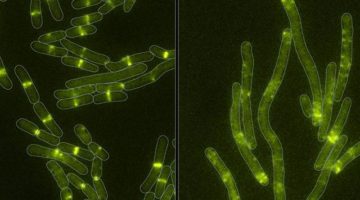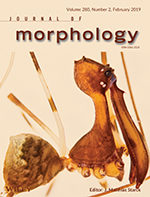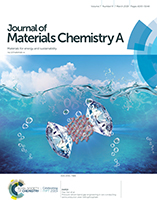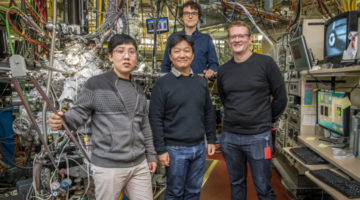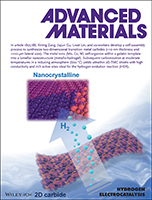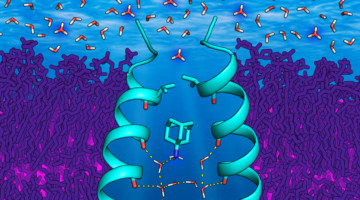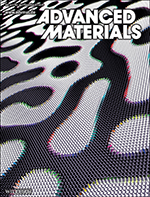Researchers solved the structure of a bacterial toxin bound to a neutralizing protein, revealing two distinct mechanisms for how the toxin-producing bacteria avoid poisoning themselves. The findings offer clues to the evolutionary origins of the potent toxins that enable bacterial pathogens to cause human diseases such as cholera and diphtheria. Read more »![]()
![]()
Comparative morphology of cheliceral muscles using high‐resolution X‐ray microcomputed‐tomography in palpimanoid spiders
Spiders are important predators in terrestrial ecosystems, yet we know very little about their principal feeding structures—the chelicerae—an extremely important aspect of spider biology. Here, using micro‐Computed‐Tomography scanning techniques, researchers perform a comparative study to examine cheliceral muscle morphology in six different spider specimens. Read more »
Pressure-driven band gap engineering in ion-conducting semiconductor silver orthophosphate
This work explores a novel method to tune the electronic band structures of active semiconductor photocatalysts to gain insight into structure–property relationships. Taking silver orthophosphate (Ag3PO4) as an example, a static pressure technique was applied to modulate the band gap and indirect–direct band character via altering its crystal structure and lattice parameters. Read more »
Revealing Hidden Spin: Unlocking New Paths Toward High-Temperature Superconductors
Researchers used spin- and angle-resolved photoemission spectroscopy (SARPES) to uncover a distinct pattern of electron spins within high-temperature cuprate superconductors. The discovery provides new insight into materials with potential for super-efficient power transmission without any loss of electron momentum. Read more »
Topological Matters: Toward a New Kind of Transistor
An experiment has demonstrated, for the first time, electronic switching in an exotic, ultrathin material that can carry a charge with nearly zero loss at room temperature. The ease in switching the material from an electrically conducting state to an insulating, or non-conducting state, bodes well for its future transistor applications. Read more »
Spatial and Temporal Correlations of XY Macro Spins
Artificial spin-ice structures have become prototypical systems to study vector spin frustration at the microscale and have recently been expanded towards XY spin systems and fundamentally fascinating phase transitions. The illustration depicts the quasi long-range ordered vortex phase in a nano disk honeycomb lattice imaged by magnetization-sensitive photoemission electron microscopy. Read more »
Self‐Assembly of Large‐Area 2D Polycrystalline Transition Metal Carbides for Hydrogen Electrocatalysis
Xining Zang et al. develop a self‐assembly process to synthesize 2D transition metal carbides (TMCs). The metal ions (Mo, Co, W) self‐organize within a gelatin template into a lamellar nanostructure. Subsequent carbonization at moderate temperatures in a reducing atmosphere yields ultrathin 2D‐TMC sheets with high conductivity and rich active sites ideal for the hydrogen evolution reaction. Read more »
ALSNews Reaches the Big 4-0-0!
Congratulations to ALSNews for reaching Volume 400! In 24 years, the ALSNews distribution list has grown from a few hundred subscribers to over 6300 in 49 countries. It has gone through 4 designs and 8 managing editors. Here we provide a short survey for your feedback and describe a bit about how it all began. Read more »
Toward a Blueprint for Anti-influenza Drugs
Researchers obtained high-resolution structures of several influenza antiviral drug molecules bound to their proton-channel targets in both open and closed conformations. The structures provide an atomic-level blueprint from which to design more effective anti-influenza drugs that can overcome growing drug resistance. Read more »![]()
![]()
Magnetic Skyrmions: Current‐Induced Skyrmion Generation through Morphological Thermal Transitions in Chiral Ferromagnetic Heterostructures
Magnetic skyrmions are particle‐like chiral twists of the magnetization that promise advances in spin‐based data storage and logic device applications. In this article, researchers examine current‐induced generation of skyrmions in heavy‐metal/ferromagnet multilayers and show that Joule heat pulses can drive topological transitions in magnetic textures and enable skyrmion creation on nanosecond timescales. Read more »
- « Previous Page
- 1
- …
- 56
- 57
- 58
- 59
- 60
- …
- 83
- Next Page »
